Paris Under Napoléon
Born in Corsica in 1769, Napoléon Bonaparte was a French military leader and statesman who rose to prominence during the French Revolution. He became Emperor of the French, known by his regnal name Napoléon I, from 1804 to 1814 and briefly in 1815.
Napoléon I is known for his military campaigns across Europe and significant legal and administrative reforms in France. After Napoléon was defeated at Waterloo in 1815, he was sent into exile on Saint Helena, one of the most remote places on Earth, from which he could not escape.
Napoléon Bonaparte is one of the most celebrated and at the same time controversial leaders in human history. If you are interested in Napoléon’s life and main achievements, keep on reading for the top sites related to Napoléon in Paris.
Suggested Napoleon Paris Tours
NAPOLEON TOUR PARIS | INVALIDES + TOMB OF NAPOLEON | OTHER NAPOLEON SITES | TRANSPORT | DURATION | PRICE |
|---|---|---|---|---|---|
YES | NO | NO | 2.5 hours | ||
NO | YES | NO | 3 hours | ||
NO | YES | NO | 2.5 hours |
Table of Contents:
Where Did Napoleon Live in Paris?
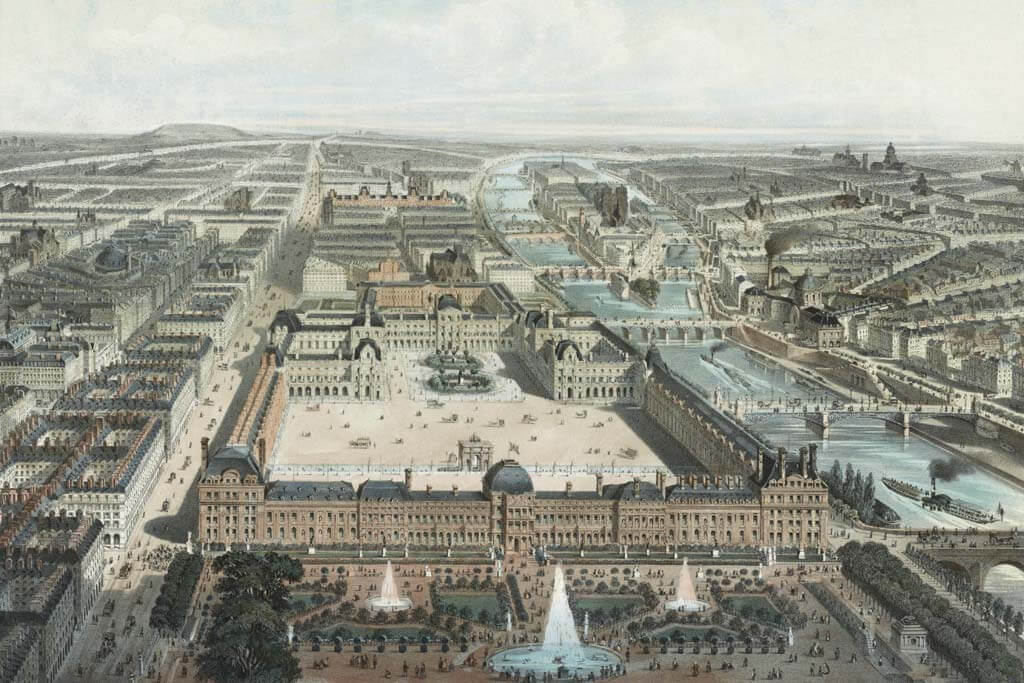
As part of his military career, Napoléon lived in many places in France. Here, however, I’ll focus on where Napoléon lived in Paris, from his first years in the capital to the Imperial residences.
- École Militaire. After his training in Brienne, the young Bonaparte stayed at the Paris Military School from 1784 to 1785. He left as a second lieutenant in the artillery, assigned to the La Fère regiment in Valence.
- Château de Malmaison. Napoléon lent 325,000 francs to Joséphine for the purchase of Malmaison. The future Emperor stayed in Malmaison from time to time.
- Château de Saint Cloud (today disappeared). This was Napoléon’s main residence when he was First Consul.
- Tuileries Palace (today disappeared). This was Napoleon’s main residence when he was First Consul and later Emperor.
Where Did Napoleon Live as Emperor?
- Château de Saint Cloud (today disappeared). When Napoléon moved to the Tuileries Palace, Saint Cloud became his secondary residence.
- Tuileries Palace (today disappeared). This was Napoléon’s main residence when he was First Consul and later Emperor.
- Château de Fontainebleau (on the outskirts of Paris). A royal residence, home to the French Kings, Napoléon regularly stayed in Fontainebleau.
Main Napoleon Sites in Paris
Below is the list of the main Napoléon sites in Paris in no particular order, where Napoléon left his mark on the city. Read the stories behind these places in Paris under Napoleon and some quirky anecdotes about his personal life.
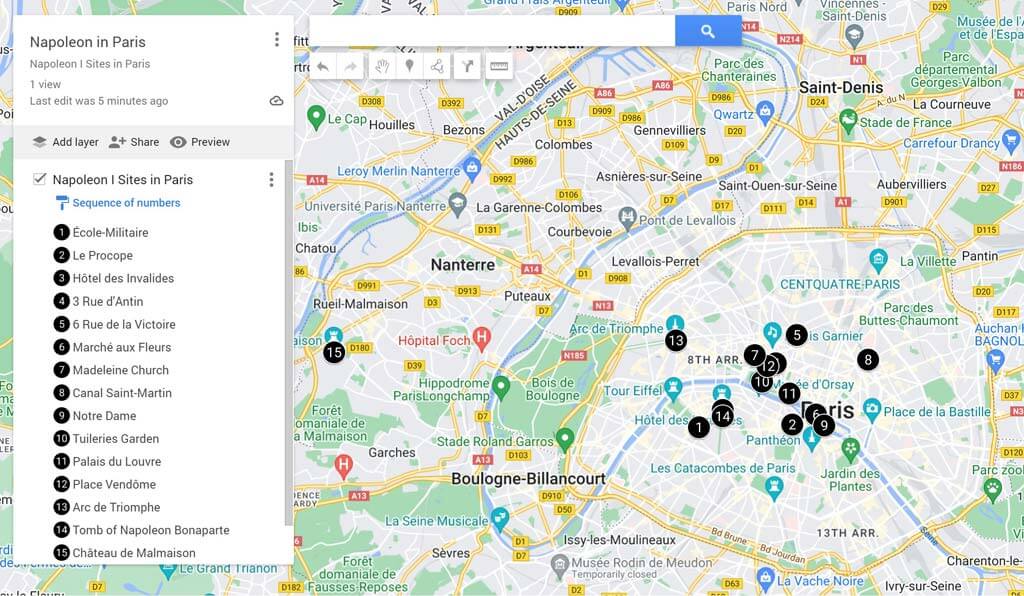
Click here to view the Napoleon Sites in Paris Map on Google
READ MORE: 55 Best Quotes about Napoleon to help you conquer the world!
1. École Militaire
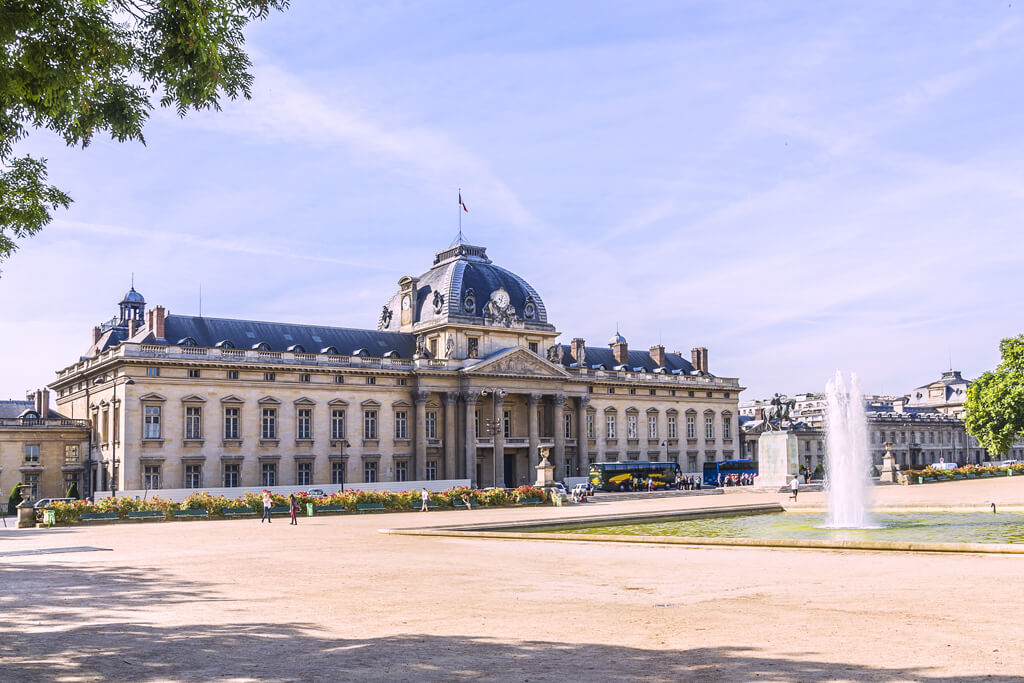
In the past, École Militaire was an academic college for cadet officers from poor noble families. It was founded by King Louis XV after the War of the Austrian Succession.
Napoléon Bonaparte entered the École Militaire in 1784 when he was 15 years old. When his father’s death reduced his income, Napoléon was forced to complete the two-year course in only one year. He was the first Corsican to graduate from the École Militaire.
The École Militaire is located southeast of Champ de Mars. It is open to visitors only during special occasions like the European Heritage Days (usually in the 3rd week of September).
Address: 1 Place Joffre, 75007 Paris
2. Café Le Procope
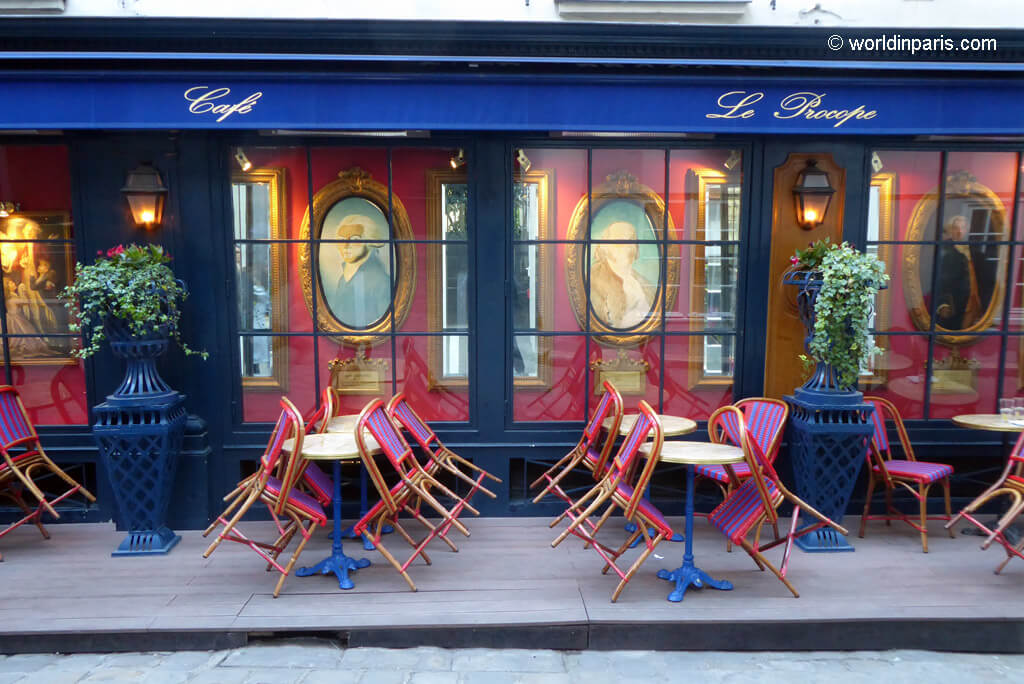
This café restaurant, located at Cour du Commerce Saint-André in the 6th Arrondissement of Paris, dates from 1686. Le Procope was a common meeting place for Napoléon and some intellectuals of the time, like Voltaire, Rousseau, and Montesquieu.
Bonaparte once left his hat at the restaurant, which you can still see in the window without entering the building.
Americans visiting Paris will be interested to know that Benjamin Franklin wrote a good part of the American Constitution at Le Procope.
Address: 13 rue de l’Ancienne Comédie / Cour du Commerce Saint André 75006 Paris
3. Les Invalides – Musée de l’Armée

The Musée de l’Armée in Paris, located inside Les Invalides, houses a fantastic collection of objects that belonged to Napoléon, as well as the uniforms and weapons of his soldiers. Here you will also find Napoléon’s Tomb (more on this below).
Make sure to see the statue of the Emperor presiding over the main courtyard – Click here to buy your skip-the-line tickets to Les Invalides
Address: 129 Rue de Grenellle, 75007 Paris.
4. Rue d’Autin – Where Joséphine and Napoleon Got Married
In this building – the former Mairie of the 2nd Arrondissement –, Napoléon and Joséphine got married. Their marriage banns were published on 7 February 1796, and the wedding was set for 9 March 1796 at 3 Rue d’Autin.
The wedding was to occur at 8 p.m. Joséphine arrived on time, dressed in a simple but fashionable muslin dress and wrapped in a warm coat, but Napoléon was nowhere in sight. After a while, the public officer who was supposed to marry the couple got tired of waiting, and he went home.
Napoléon did not arrive at his wedding until 10 p.m. as he lost all track of time with his maps, and it was the acting registrar who married the couple. The marriage took less than 30 minutes to complete.
The wedding certificate purposely contained all sorts of false information. Joséphine was 6 years older than Napoléon. To avoid the humiliation she might feel, Joséphine’s birth date was changed from 23 June 1763 to 23 June 1767, which made her four years younger. As an act of gallantry, Napoléon also changed his birth date to make him 18 months older.

5. Rue Chantereine – The Wedding Night
For the wedding night, Napoléon went to Joséphine’s house that she was leasing at 6 Rue Chantereine, located in a fashionable part of Paris called Chaussée D’Antin. But just like the wedding ceremony, the wedding night did not go exactly as expected, and Napoléon found himself using his military skills rather than his lover’s skills. Here’s the story:
Joséphine owned a pug named Fortuné. Apparently, Fortuné was not inclined to share the bed (and Joséphine) with Napoléon, even on her wedding night! When Napoléon attempted to get into bed, Fortuné bit him on the shin.
Although we don’t know who won the battle, Napoléon’s war against Fortuné did not last long. Two days later, Napoléon had to leave Paris to join his army in Italy.
Joséphine’s house – also known as Hotel Bonaparte – was one of the most beautifully decorated in Paris. From this house, Napoléon orchestrated the coup d’etat, which brought him to power on 9 November 1799.
Unfortunately, the Hotel Bonaparte was demolished during the Second Empire to make way for the current Rue de Châteaudun. Today, Rue Chanteraine is named Rue de la Victoire. It took this name in 1797 after the success of Napoléon’s campaign in Italy.
6. Marché aux Fleurs
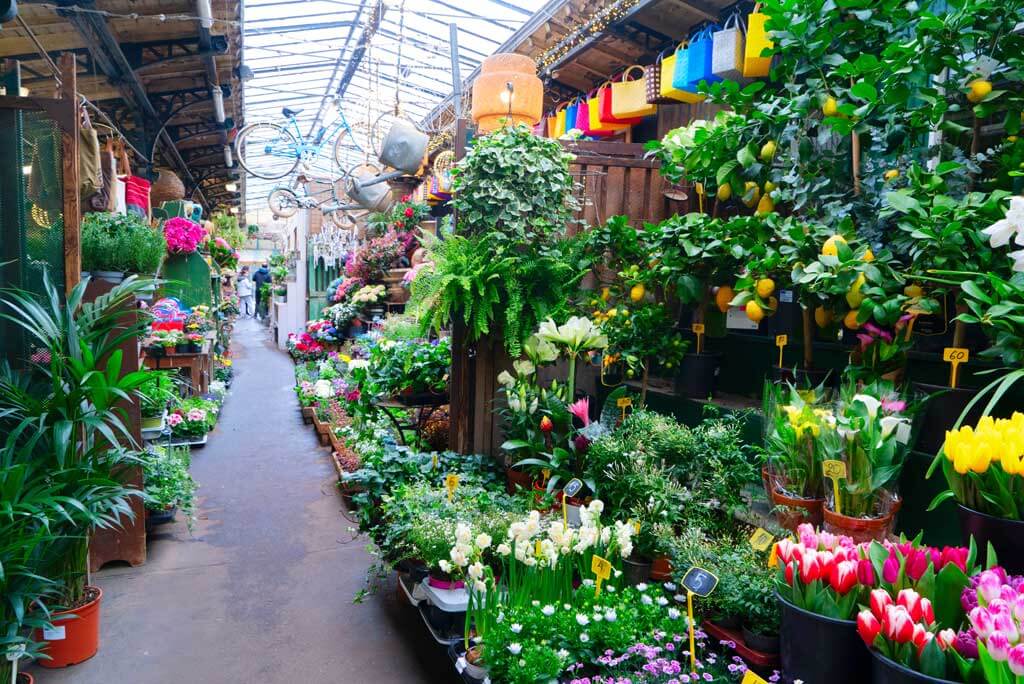
In 1808, Napoléon signed a decree to cede the vacant land on the Ile de la Cité to the City of Paris to accommodate a floral market.
Today, the Marché aux Fleurs is a must-see in Paris and always stands out for the profusion of flowers and shrubs. Now renamed the Queen Elizabeth II Flower Market, its metal pavilions have been rebuilt several times and are not from Napoléon’s time.
Address: Place Louis Lépine – Allée Célestin Hennion, 75004 Paris
7. Madeleine Church
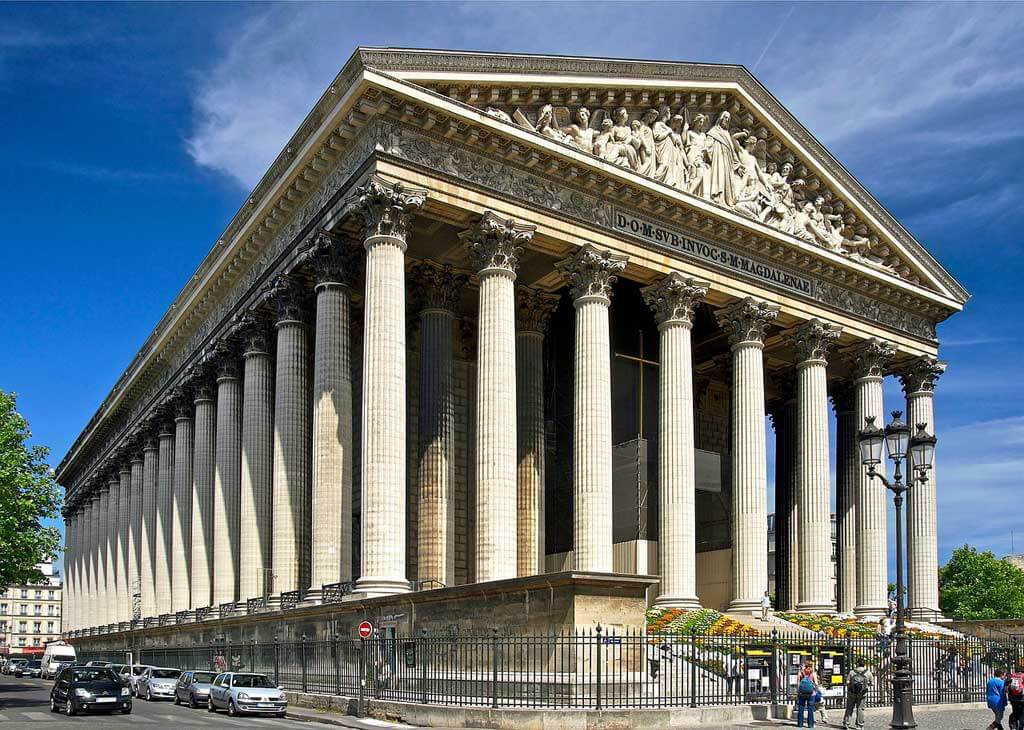
Napoléon commissioned the Madeleine as a temple dedicated to his military services. However, the construction was finished long after his rule, and in the end, the city decided to turn the temple into a church.
Just in front of La Madeleine, but on the other side of the Seine River, there is the National Assembly building. Napoléon ordered to cover the back of the National Assembly, which is the side facing La Madeleine, with a similar colonnade, so today, these two buildings look like twin buildings.
Address: Place de la Madeleine, 75008 Paris.
8. Canal Saint-Martin – Bring them Water!
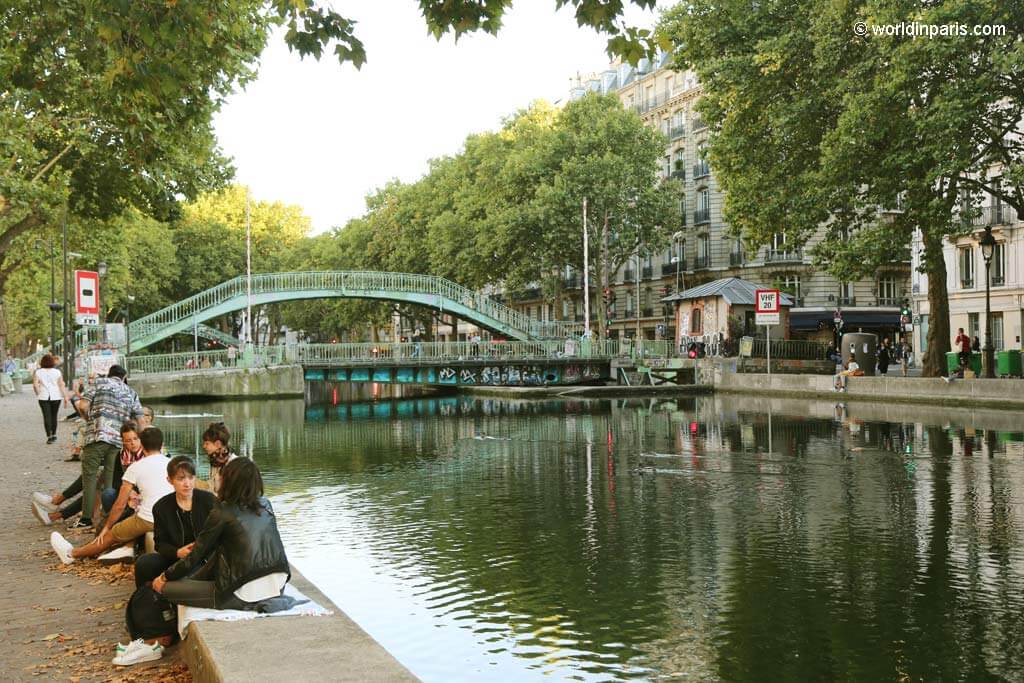
Canal Saint-Martin is today a lovely area for a stroll or a romantic cruise in Paris. The construction of the canal was ordered by Napoléon in 1802 when he was First Consul. It is said that Napoléon asked Gaspard de Chabrol, prefect of the city of Paris, “What can I do for the Parisians?” And Chabrol answered: “Bring them water!”
Until that moment, Parisians only had access to a small supply of drinking water from the Bièvre River and the Seine River, often very polluted.
A new tax on wine funded the construction of the Canal Saint-Martin. The canal is fed by the Ourq River, located 100 km northeast of Paris.
This new source of fresh water and its fountains helped to avoid diseases such as dysentery and cholera. The canal was also used to transport different goods on big boats. If you are looking for original activities in Paris far from the crowds, this Canal Saint-Martin boat tour is a fun way to explore a lesser-known side of Paris.
9. Notre Dame Cathedral
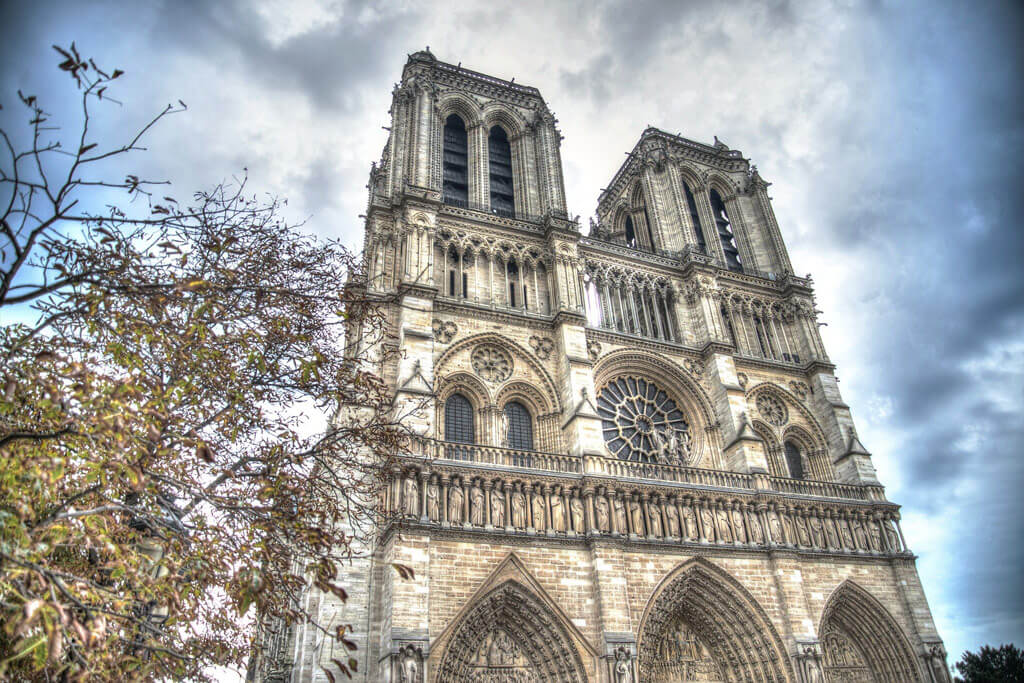
Notre Dame Cathedral in Paris was the place where Napoléon was crowned Emperor of France. The ceremony took place on 2 December 1804 in the presence of Pope Pius VII.
For this occasion, the Gothic interior of Notre Dame was turned into a Roman temple. On the facade, a triumphal arch was erected resting on four columns, two of which symbolized the Merovingian and Carolingian dynasties and the other two the ‘good towns of France.’ The Capetians (King Louis XVI’s dynasty) were knowingly forgotten.
The future Emperor and Empress arrived at Notre Dame separately, and they received the triple anointing from the hand of the Pope.
Against all usage, Napoléon wished to crown himself before taking the constitutional oath at the end of the coronation. He also crowned Empress Joséphine, so the Pope had to content himself with blessing the crown. Here’s how to visit Notre Dame Cathedral after the reopening in December 2024.
Address: 6 Parvis de Notre Dame, 75004 Paris
10. The Tuileries Palace and Tuileries Garden

The Tuileries Palace was Napoléon’s residence in Paris. Located on the right bank of the River Seine, the Tuileries Palace was home to many French kings, from King Henri IV to Napoléon III, until the Paris Commune burned it down in 1871.
Napoléon turned the Tuileries into the official residence of the First Consul. When Napoléon was crowned Emperor, the Tuileries Palace became the Imperial Palace.
The Tuileries Palace was redecorated in the Neoclassical Empire style by the best architects of the time. Today, visitors wandering around the Tuileries Garden can still see a few remains of the Palace on the side alleys.
TIP: learn the history of the Tuileries Garden whilst having fun with this self-guided scavenger hunt!
11. Louvre Palace
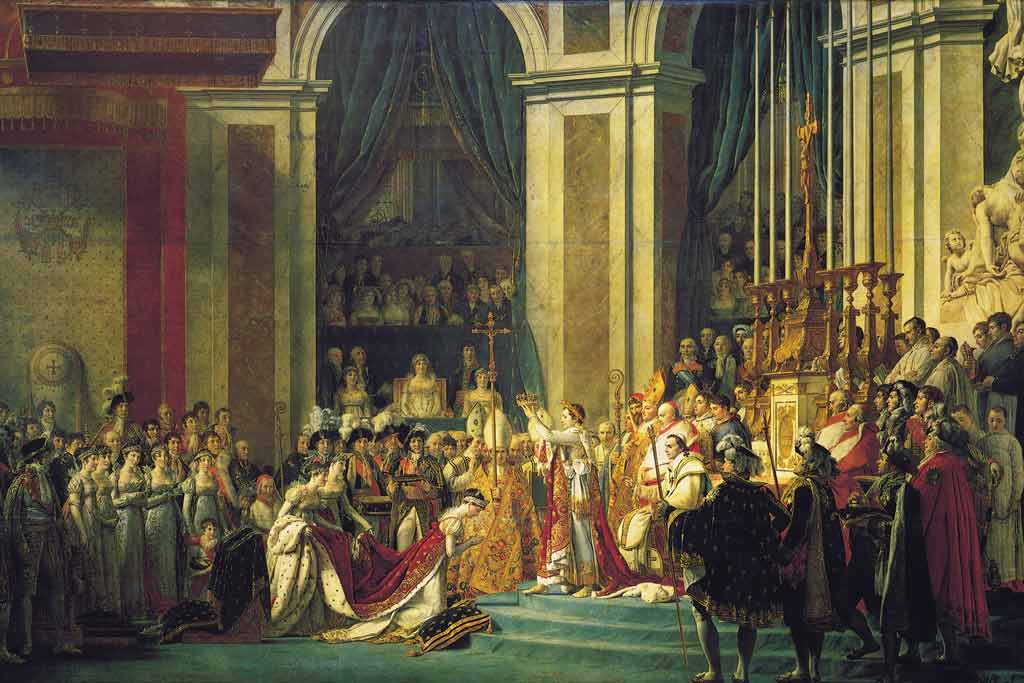
The Louvre Museum is one of the most famous museums in the world. Home to the Mona Lisa and the Venus of Milo, the Louvre also displays the 6×10 meter painting by Jacques-Louis David on Napoleon’s Coronation Ceremony. It is really impressive!
The resemblance of the characters and the detail of the costumes give this painting the realism of a portrait gallery – Click here to buy your tickets to the Louvre Museum
Address: Rue de Rivoli, 75001 Paris
Did Napoléon live in the Louvre?
During his time as a Consul and later as Emperor, Napoléon never lived in the Louvre Palace. Here’s what Napoleon thought about the Louvre:
The Louvre will never be a comfortable dwelling. I see it as a parade palace in which you have to bring together all that you have in terms of objects of art and science, such as statues, bronzes, paintings, libraries, archives, and medals.
However, Napoléon multiplied artistic acquisitions throughout Europe and ordered works at the Louvre in order to welcome and present these treasures with dignity.
12. Place Vendôme
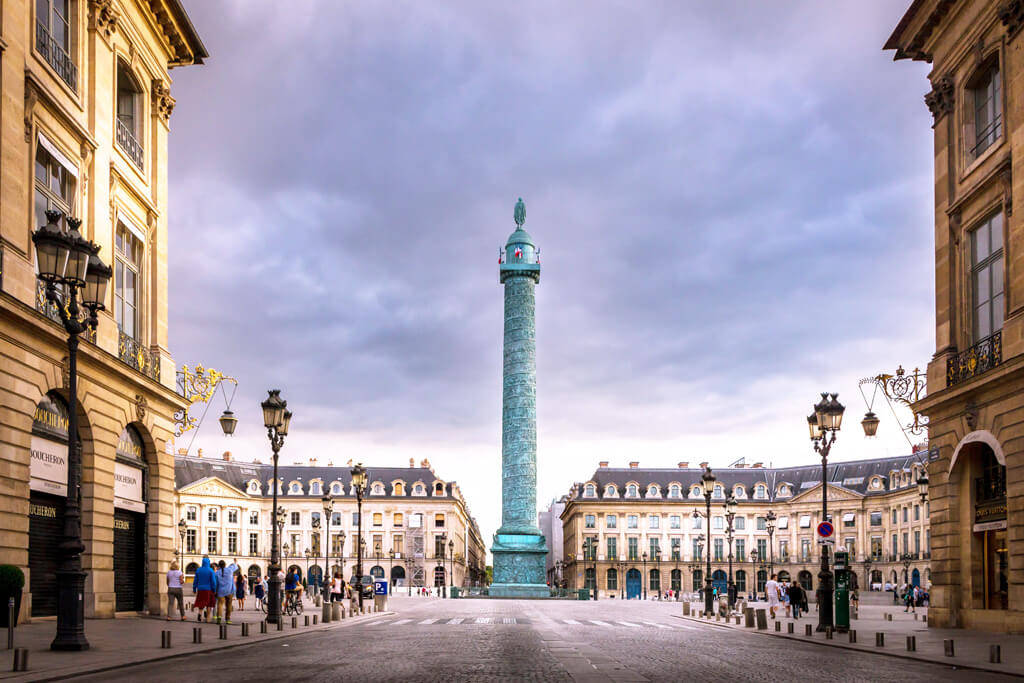
Place Vendôme, in the 1st Arrondissement, is one of the royal squares in Paris and one of the most important Napoléon sites in Paris. Here, you can see the column of the same name – the Colonne Vendôme – which was commissioned by Napoléon in honor of his victory at Austerlitz in 1805.
The column is of bronze, and many scenes of the battle are sculpted around it. On top of the column, there is a Napoléon statue represented as Caesar, overlooking the Tuileries and Paris.
13. Arc de Triomphe
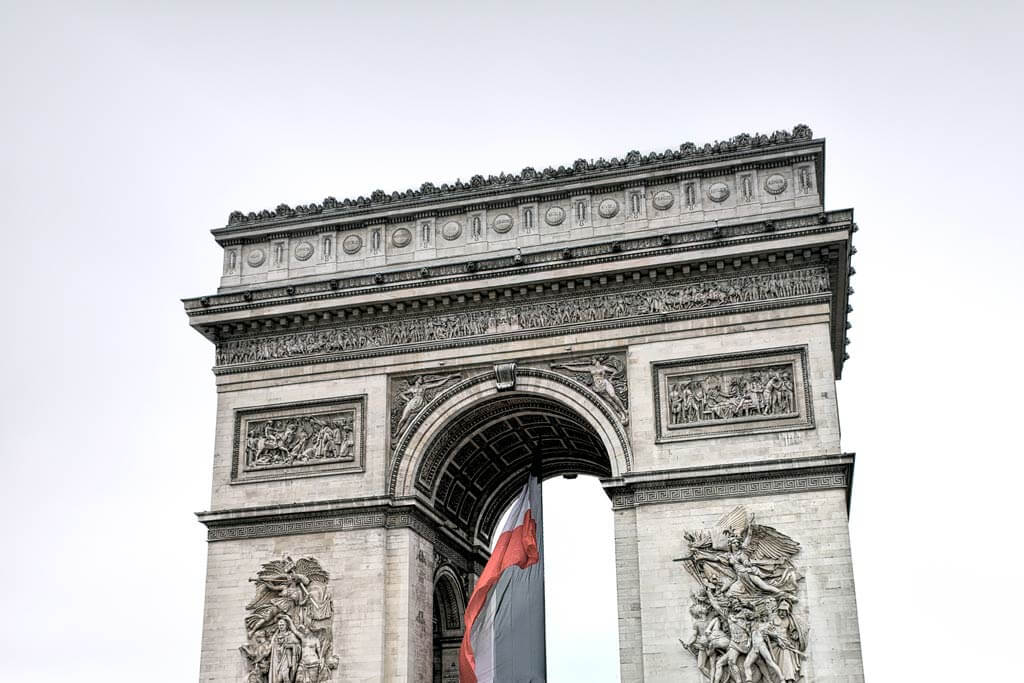
In Paris, Napoléon commissioned the famous Arc de Triomphe in 1806 to celebrate his victory at Austerlitz and to memorialize the heroes of the war. However, Napoléon died before its completion, and the Arc de Triomphe was inaugurated in 1836 under the reign of King Louis-Philippe.
The Arc de Triomphe is located in the 8th Arrondissement, and you can climb up to the top for one of the best views of Paris! –Click here to buy your tickets to the Arc de Triomphe
Address: Place Charles de Gaulle, 75008 Paris
15. Château de Malmaison

Château de Malmaison was one of Napoléon’s residences in the countryside, not far from Paris. The Château was bought in 1799 by his wife Joséphine, when Napoléon was First Consul.
One of the best castles near Paris to visit, Château de Malmaison was, together with the Tuileries Palace, the heart of the French government during the Consulate.
Napoléon spent long periods in Malmaison. When he became Emperor of France in 1804, the couple moved to the Château of Saint-Cloud, more worthy of Napoléon’s new rank.
Napoleon and Joséphine, however, frequently visited Malmaison until their divorce in 1809. After the divorce, Joséphine kept Malmaison, where she died.
This Napoléon residence makes a beautiful half-day trip from Paris. It is located 16 km east of the capital and it is very easy to reach by public transportation.
TIP: the entrance to Château de Malmaison is included in the Paris Museum Pass. You can read our Paris Museum Pass review here.
Napoléon’s Tomb in Paris (or Should I Say Napoléon’s Tombs?)
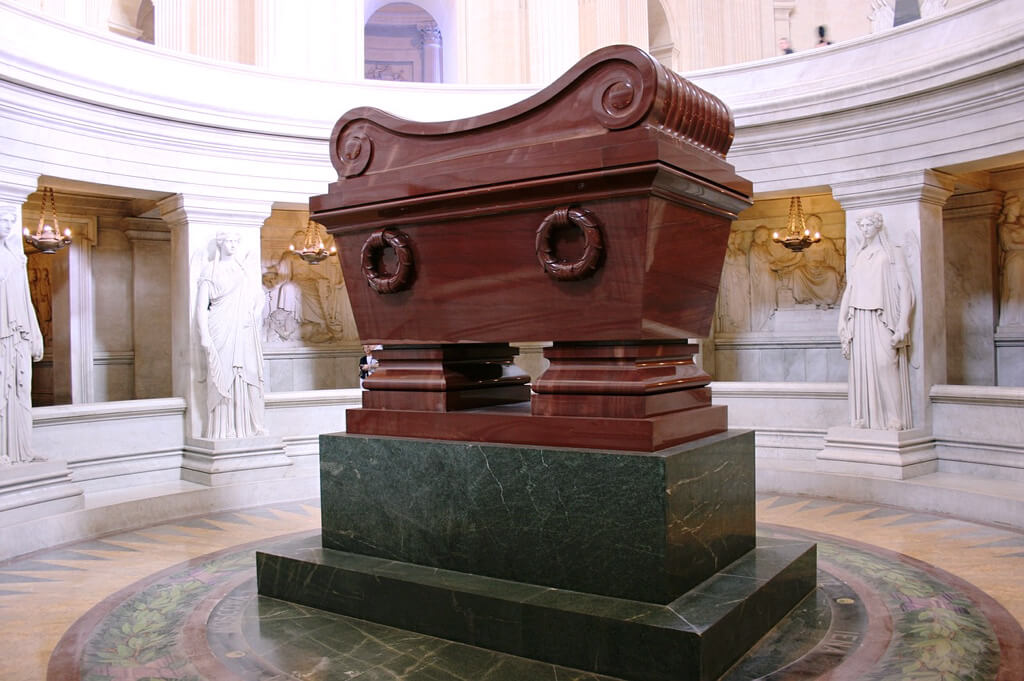
Wondering where Napoléon is buried? You can find Napoléon’s Tomb at Les Invalides, and more precisely inside the Dome Church.
Napoleon lies in a five-layer coffin placed under the dome of the church. The remains of Napoléon were brought here from Saint Helena in 1840, 19 years after his death.
What perhaps you didn’t know is that there’s a second tomb of Napoléon in Paris, and I’ll tell you about its hidden location in this article about the Napoléon Tombs.
TIP: Taking place at nighttime, Aura Invalides is an immersive experience that showcases this iconic Parisian building through lights, video mapping, and orchestral music. Get ready to discover the Dôme des Invalides’ rich architecture and heritage, where you will uncover illuminating revelations. This is a unique, multisensory tour that will surely be unforgettable! – Click here to buy your ticket to Aura Invalides
Sleep Like Napoléon in Paris
Hotels can be so much more than a simple place to rest your head. For some travelers, the right hotel is part of what makes the travel experience an interesting one.
If you are a fan of Napoléon, book your stay at one of the Napoleon-themed hotels for a total Napoléon experience. These hotels certainly know how to give their guests a memorable stay in a “First Empire” atmosphere!
Hotel Napoléon Paris
Located in Paris 8, at a stone’s throw from the Champs-Elysées and the Arc de Triomphe, Hotel Napoleon Paris is a romantic and luxurious hotel inspired by Emperor Napoléon.
The spacious and beautiful rooms are decorated in an elegant Empire style with a contemporary touch. This is also one of the best hotels with an Eiffel Tower view (from some rooms), the Arc de Triomphe, or both! Rare in Paris, the large connecting rooms are ideal for families – Click here for the Latest Prices
Hotel de l’Empereur
Napoléon fans cannot go wrong with a hotel dedicated to France’s first Emperor. Hotel de l’Empereur is located in Paris 7, not far from the Eiffel Tower, and it features awesome views of Les Invalides and its imposing golden dome.
The hotel is decorated in an elegant and luxurious Empire style, with beautiful fabrics and furniture. The rooms are spacious and with large and well-lit bathrooms. Most of the rooms come with a view of the Invalides Dome – Click here for the Latest Prices
Hotel de Joséphine Bonaparte
Located in the historic neighborhood of Le Marais and hidden behind a flamboyant courtyard, Hotel de Joséphine Bonaparte is the intimate and delightful refuge after a long and busy day following Napoléon’s steps.
Joséphine Bonaparte and the Directoire style inspire the hotel’s design right down to all the carpentry details. Rooms are individually decorated – each with its own character – and they all have interesting fabrics, wallpapers, and unique carpets.
The hotel offers connecting rooms to create your private apartment – Click here for the Latest Prices
Napoléon Statues in Paris
In Paris, there are still some Napoléon statues or sculptures outdoors or in places easy to spot.
» The Genius of France in the guise of Napoléon. This sculptural set is located in the Louvre Museum at Cour Carrée. It decorates the pediment of the north wing.
» Goddess Minerva, surrounded by the muses of Victory, crowns the bust of Napoléon. This sculptural set is located in the Louvre Museum; it decorates the pediment of Pavillon Marsan.
» Napoléon Triumphant. This statue is found inside the Louvre Museum at Cour Puget.
» Napoléon as Cesar. This is the statue on the top of the Vendôme Column at Place Vendôme.
» Napoleon I dominates History and the Arts. This sculptural set is located in the Louvre Museum; it decorates the pediment of Pavillon Sully.
» Renowned, crowning the bust of Napoléon. This sculpture is located in the Louvre Museum, in the Cour Carrée, south wing.
» Napoléon I. Statue located at the Courtyard of Honor of Les Invalides.
» Napoléon I dressed in coronation attire. Statue located in Napoléon’s crypt at Les Invalides.

